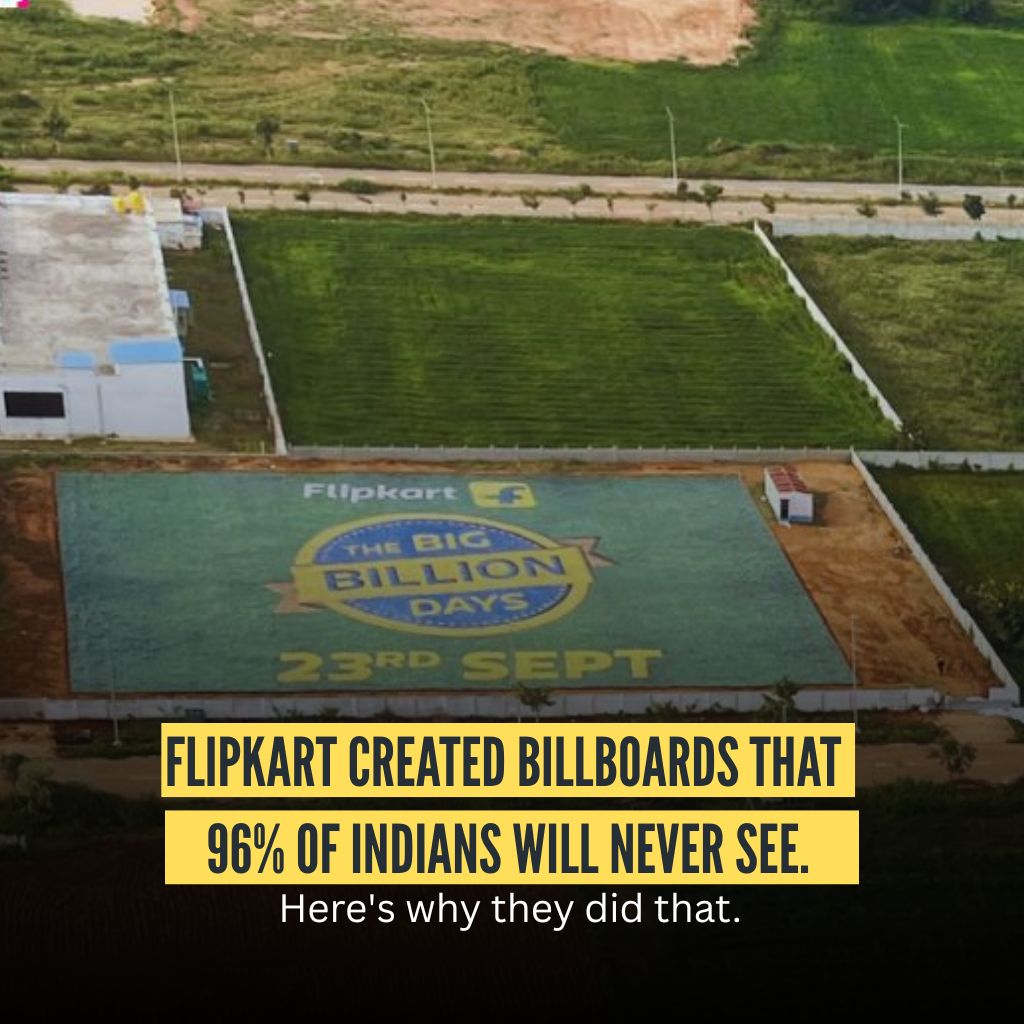
Flipkart created giant crop circles to promote its Big Billion Days sale, but the real genius was not the stunt...
Author: Akash Gupta | AI Generalist & Content Specialist, Fresio Media
India — September 24, 2025
For years, brands fought for billboard space. They spent millions on TV commercials. Now, Flipkart has gone in a completely different direction. It chose the sky.
The e-commerce giant created massive crop circle installations. They are only visible from thousands of feet up. This aerial marketing stunt for their Big Billion Days sale has everyone talking. It’s a masterclass in modern marketing.
This isn’t about impressions. It’s about creating a moment. It’s about generating a story people want to share. This article breaks down why this bold move is a glimpse into the future of advertising.
Want to build a talk-worthy brand? Let’s discuss a strategy that goes beyond the usual. Let’s Talk!
Flipkart’s campaign is not about direct reach, but about creating buzz and earned media.
The stunt proves that unexpected, experiential marketing can have a higher ROI than traditional ads.
This approach is a lesson for all brands: innovate with your perspective, not just your budget.
What Is Aerial OOH Marketing?
The Strategy Behind Flipkart’s “Talk-Worthy” Campaign
ROI Beyond Impressions: The Power of Earned Media
The Future of Advertising Is Experiential
How Smaller Brands Can Learn From This
The Big Billion Days Case Study: Turning Farmlands Into Billboards
Common Mistakes Brands Make With Viral Marketing
Frequently Asked Questions (FAQs)
Conclusion
Aerial Out-of-Home (OOH) marketing uses the sky as a canvas. This can include billboards on blimps or skywriting. It’s a type of guerilla marketing. It grabs attention in a big way.
In short: Aerial OOH is a non-traditional marketing method that uses the sky or airspace to display advertisements.
Flipkart’s campaign is India’s first aerial OOH stunt. It is designed for airline passengers. The installations were placed near Bengaluru and Kanpur airports. This targets a specific, high-value demographic.
“This is a first-of-its-kind campaign,” said a Flipkart spokesperson. “It’s about turning the mystery of crop circles into magic, which truly embodies the spirit of our ‘Kuch Bhi Ho Sakta Hai’ tagline for the Big Billion Days.”
— Source: The Economic Times, September 20, 2023
This quote confirms the strategic intent. The campaign is about magic and possibility. It directly links the a-ha moment to the brand’s core message.
Flipkart did not create this for direct sales. They did it for buzz. The goal was to create a moment. Something people would share and discuss.
In short: The core strategy was to bypass traditional advertising channels and generate free, organic media coverage and social sharing.
The campaign’s success is not measured in eyeballs. It’s measured in media mentions. It’s about social shares and public conversation. Every article written and every tweet shared becomes free advertising. This is called earned media.
This approach is highly effective. It builds brand reputation and cultural relevance. It makes a brand seem innovative and clever. This is a crucial element of modern marketing.
The return on investment (ROI) here is not from direct clicks. It’s from a broader impact. The campaign’s true value lies in its earned media.
In short: Earned media is unpaid publicity generated by public relations efforts, social media, and word-of-mouth.
This campaign was designed to be a story. A story the media wanted to cover. A story people wanted to talk about. The small number of travelers who saw it are a bonus. The real prize is the millions who heard about it.
Consider this: A single article in a major publication can reach millions. A viral social media post can reach millions more. All of this for the cost of a few crop circles. This is a far better return than a traditional billboard.
The Flipkart campaign shows a major shift. Brands are moving from “What we sell” to “What we do.” They are creating experiences. These experiences are what build strong connections with customers.
In short: Advertising is evolving from simple messaging to creating memorable, shareable brand experiences that resonate with audiences.
The goal is not to sell a product. It is to build a feeling. Red Bull is a perfect example. They don’t just sell energy drinks. They sponsor extreme sports events. This associates their brand with adventure and daring.
This type of marketing builds brand loyalty. It makes customers feel part of a community. It creates a story that they can become a part of.
You don’t need a massive budget to learn this lesson. The principle is the same. Think about what is unexpected in your industry.
In short: Smaller brands should focus on creating unexpected, creative actions that generate buzz without requiring a huge budget.
Find a small, unique way to stand out. Can you do something different at a local event? Can you create an online challenge? Can you partner with a local artist?
Innovation is about perspective. It’s not always about money. For example, a local bakery could bake a giant cake for a public festival. They could document the process online. This creates a memorable moment. It gets people talking. And it costs far less than a TV ad.
The Flipkart campaign was genius. It was located on farmlands. Near the approach and departure paths of two major airports. The crop circles were intricate. They featured the Flipkart logo and the “Big Billion Days” text.
The stunt was planned for maximum impact. It was timed to coincide with a major travel season. It was designed to intrigue. People on planes would see it and wonder. That sense of mystery is what makes people talk.
The campaign’s tagline, “Kuch Bhi Ho Sakta Hai” (Anything is possible), was perfectly tied to the visual. The unexplainable crop circles were a physical representation of the slogan.
This campaign is a classic example of guerilla marketing. It is low-cost, high-impact. It relies on creativity and surprise. It proved that you don’t need to shout the loudest. You just need to be the most interesting.
Focusing on Shock Value: Creating a controversial stunt just for attention can backfire. It can alienate your audience and damage your brand reputation.
Forgetting the Brand: The stunt must be aligned with your brand message. Flipkart’s stunt was tied to their tagline.
No Follow-Through: A viral campaign needs a plan. You need to leverage the buzz. Have a clear call-to-action or follow-up content ready.
Underestimating the Cost: While creative, these stunts are not free. Don’t go into it without a solid budget plan.
Ignoring Measurement: Even with earned media, you must track results. How many shares? How many media mentions? What is the sentiment?
Q: What is the Flipkart crop circle campaign?
In short: The Flipkart crop circle campaign was an aerial marketing stunt for their Big Billion Days sale, where they created large, logo-shaped formations on farmlands near airports in Bengaluru and Kanpur to be seen by air travelers.
A: The campaign was a highly unusual form of Out-of-Home (OOH) advertising. Instead of traditional billboards, Flipkart utilized farmlands to carve out massive crop circles featuring its branding. These were strategically placed beneath flight paths, ensuring visibility to thousands of people flying in and out of two of India’s busiest airports. The primary goal was not direct sales but to generate widespread media and social buzz, positioning the brand as innovative and creative.
Q: Why did Flipkart use crop circles for advertising?
In short: Flipkart used crop circles to create an unexpected, mysterious, and highly shareable moment that would generate free media coverage and social buzz far beyond the few people who saw it directly.
A: The decision to use crop circles was a deliberate strategic choice to create a “talk-worthy” event. By tapping into the intrigue and mystery associated with crop circles, Flipkart made a memorable statement. This campaign’s success isn’t measured by the number of travelers who saw the ad but by the millions of people who read about it in newspapers, saw it on social media, and discussed it online. It was a calculated move to secure earned media.
Q: Is this type of marketing effective?
In short: Yes, this type of experiential and buzz-driven marketing is highly effective because it builds brand reputation and cultural relevance by generating powerful word-of-mouth and earned media, which often has a higher ROI than paid advertising.
A: This approach is incredibly effective for large brands that want to create a narrative and a cultural moment. While traditional ads can be easily ignored, a unique stunt like this becomes a story. It generates trust and interest, leading to increased brand loyalty and consideration. It’s a shift from “advertising at people” to “creating something people want to be a part of and share.”
Q: How does this campaign compare to traditional OOH advertising?
In short: Unlike traditional OOH which focuses on reaching a local audience with a static message, Flipkart’s aerial OOH campaign used a physical installation to trigger a massive digital and media conversation, with the goal being earned media, not just impressions.
A: Traditional OOH, such as billboards, aims for high visibility and repeated exposure to a local audience. Its success is measured by impressions and direct action. In contrast, Flipkart’s campaign had a limited direct audience. Its true power was in its novelty. It was a one-off event designed to be photographed, shared, and amplified by digital media, giving it a global reach far beyond its physical location.
Q: Can smaller brands do something similar?
In short: Smaller brands can’t replicate the scale of the Flipkart campaign but can adopt the underlying principle of creating an unexpected, memorable, and shareable moment within their own niche and budget.
A: Absolutely. The core lesson is to think creatively. A small coffee shop could organize a “reverse graffiti” art project by cleaning a dirty wall in the shape of their logo. A local gym could hold a surprise fitness flash mob in a public park. The principle is the same: do something unexpected, make it easy to share online, and tie it back to your brand’s message. Innovation is about perspective, not just scale.
Flipkart’s aerial campaign is a bold statement. It shows where marketing is headed. It’s a move away from shouting the loudest. It’s a shift toward creating the most interesting story. The campaign’s success proves that a unique idea is more valuable than endless ad spend. The future of marketing is not about just reaching people. It’s about giving them something to talk about.
Ready to create a campaign that breaks through the noise? Talk to us today.
“Flipkart’s Big Billion Days campaign takes to the skies with first-of-its-kind aerial marketing” — The Economic Times Brand Equity — September 20, 2023 — https://brandequity.
economictimes.indiatime
s.com/news/advertising/
flipkarts-big-billion-days-campaign-takes-to-the-skies-with-first-of-its-kind-aerial-marketing/103823793
“Flipkart’s Big Billion Day 2023 campaign takes over farmlands to create ‘crop circles’” — Financial Express — September 20, 2023 — https://www.financial
express.com/business/
e-commerce-flipkarts-big-billion-day-2023-campaign-takes-over-farmlands-to-create-crop-circles-3253670/
“Flipkart turns farmlands into billboards for its Big Billion Days campaign” — Business Insider India — September 21, 2023 — https://www.business
insider.in/advertising/
brands/article/flipkart-turns-farmlands-into-billboards-for-its-big-billion-days-campaign/articleshow
/103833214.cms

Flipkart created giant crop circles to promote its Big Billion Days sale, but the real genius was not the stunt...

Don't want to pay for real estate leads? This guide shows you 10 proven, free methods to generate clients, from...

The proposed US policy to block IT outsourcing could severely damage India's $300 billion IT sector. But this crisis also...

Learn how to get real estate leads from social media with free and paid strategies. A step-by-step guide for real...

Want to know how real estate agents get leads without cold calling or wasting ad spend? This detailed guide shares...

Learn how to master AI, including machine learning, chatbots, and generative AI. Discover practical tools, ethical considerations, and build your...